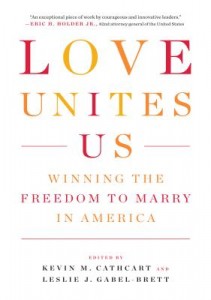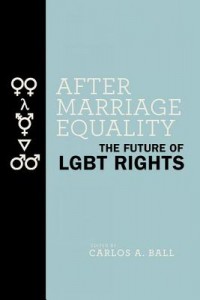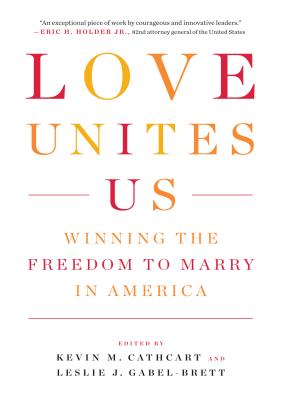 Love Unites Us: Winning the Freedom to Marry in America
Love Unites Us: Winning the Freedom to Marry in America
Edited by Kevin M. Cathcart and Leslie J. Gabel-Brett
New Press. 352 pages, $27.95
 After Marriage Equality: The Future of LGBT Rights
After Marriage Equality: The Future of LGBT Rights
Edited by Carlos A. Ball
NYU Press. 368 pages, $45.
HALF A YEAR into the Trump Presidency, and it is often hard to remember that anything preceded it. Movement activists find themselves preoccupied with scenarios that may at any moment materialize. How will Jeff Sessions wield his power in the Department of Justice to chip away at LGBT rights? Will the Department of Education under Betsy DeVos make schools less safe for LGBT youth? Will Religious Freedom Restoration Acts pass in Republican-dominated state legislatures and create new forms of discrimination? Will a more conservative Supreme Court encourage officials in red states to bring cases challenging the right to marry?
I am not dismissing these concerns. But we also need to carry into the coming years a sense of history, an awareness of our accomplishments, and how they were attained. History reminds us of what has worked and what has not. It offers lessons about what remains to be achieved and how best to reach our next goals.
Two anthologies put together before Trump’s nomination and published before his election encourage reflection on our recent history and its lessons. They also complement one another well and deserve to be read together. Love Unites Us reviews the fight for marriage equality. Its contributors are, almost without exception, individuals who worked on the issue: plaintiffs who sued for their right to marry; lawyers who argued cases; and activists who mobilized against anti-marriage ballot initiatives and for freedom-to-marry legislation. By contrast, After Marriage Equality addresses the question of what is next now that marriage has been attained.
The title of Love Unites Us perfectly captures the book’s core message. In essay after essay, partisans in the struggle describe the love implied by a desire to marry as a bond that forges a common humanity. More than any other battle that gays and lesbians have fought, the marriage issue allowed heterosexuals to identify with them rather than treat them as an alien “other.” Family, friends, neighbors, coworkers, legislators, and judges could see in the couples fighting for access to marriage people just like them. The joy, the commitment, the passion—a desire for marriage made this all legible to masses of heterosexuals and, in the process, made the homosexual suddenly familiar.
Besides the joy echoing through these essays, there are also stories of heartbreaking defeats and acknowledgment of strategic and tactical errors. While many of the contributors are lawyers who prepared and argued the cases, the anthology moves beyond legal arguments. One learns about the dialogue and planning among activist lawyers that eventually produced a state-based strategy and messaging that stressed love and commitment rather than rights and legal status. Essays describe the grassroots organizing that mobilized the LGBT community from the ground up in states like Connecticut and Florida, and that pulled in many allies. Activists of color testify to how their communities were often ignored by leaders of the marriage equality movement even as greater support for the right to marry developed in these populations. I learned that the marriage fight elicited from rich donors, like the Evelyn and Walter Haas Jr. Fund and the Gill Foundation, contributions of a size far beyond what LGBT organizations typically received.
By the end of the volume, I have to confess that I had heard enough about joy. The theme so pervades the individual essays that it comes to sound less than authentic and more like a messaging technique so fully absorbed that it saturates these narratives. Still, I will also confess to having been swept up in the drama and excitement that these participants convey. Many of these essays were page-turners.
After Marriage Equality is a very different kind of anthology. Its essays are analytical rather than descriptive, critical rather than celebratory. Yes, marriage equality was, in the words of Carlos Ball, “a monumental achievement,” but that is not the whole story. Most contributors point to ways that the issue, and how it was framed, brought burdens that the LGBT movement and individuals will have to bear. Katherine Franke, a legal scholar at Columbia, describes the battle for marriage as “essentially conservative in nature,” and other contributors concur. By choosing litigants designed to appear most palatable to judges, the media, and a heterosexual heartland, movement lawyers effectively invalidated the sexual and gender nonconformity that characterize the lives of many people. By arguing that children raised in same-sex households needed to have married parents to feel okay, they strengthened the stigma that attaches to single parenthood. A drive toward assimilation, respectability, and conformity surfaces again and again in the critiques of contributors.
Other issues are raised as well, the validity of which will be determined by the passage of time. Will the heavy reliance on litigation lead to the demobilization of activists? Will the exaggerated claims about the meaning of marriage equality—one lawyer told his clients they were now free to live the American dream and live happily ever after—produce a serious decline in revenue sources for community organizations? Will pressing issues like HIV prevention, sex education, curriculum inclusion, the needs of LGBT elders, and the absence of anti-discrimination legislation in a majority of states get the resources and attention they deserve?
If I had to pick one essay from these two anthologies that most speaks to the challenges of the Trump era, it would be “Still Not Equal: A Report from the Red States,” by Clifford Rosky, who teaches at the University of Utah and has lived through fights over marriage equality and other issues in a political environment that’s not queer-friendly. In dramatically contrasting ways, he defies what might be described as conventional thinking in the mainstream LGBT movement. He points to the solid control that Republicans have in many state legislatures and argues that laws prohibiting discrimination as well as other measures that might lead to meaningful equality will only come by forming unlikely coalitions with Republicans. Yet he also identifies the legislative redistricting of Congressional seats that will occur after the 2020 census as more important than any other issue LGBT activists might embrace. Will the single-issue stance that has shaped so much LGBT politicking be able to reorient itself to that assessment? If not, we can expect an even longer era of Republican rule, even as some of us plan our weddings.
John D’Emilio has written widely on LGBT history and the history of sexuality, and is currently writing a coming-of-age memoir about his life in New York City in the 1950s and ’60s.






